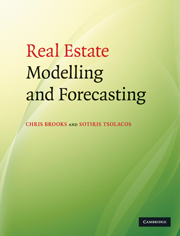Book contents
- Frontmatter
- Contents
- List of figures
- List of tables
- List of boxes
- Preface
- Acknowledgements
- 1 Introduction
- 2 Mathematical building blocks for real estate analysis
- 3 Statistical tools for real estate analysis
- 4 An overview of regression analysis
- 5 Further issues in regression analysis
- 6 Diagnostic testing
- 7 Applications of regression analysis
- 8 Time series models
- 9 Forecast evaluation
- 10 Multi-equation structural models
- 11 Vector autoregressive models
- 12 Cointegration in real estate markets
- 13 Real estate forecasting in practice
- 14 The way forward for real estate modelling and forecasting
- References
- Index
9 - Forecast evaluation
Published online by Cambridge University Press: 05 June 2012
- Frontmatter
- Contents
- List of figures
- List of tables
- List of boxes
- Preface
- Acknowledgements
- 1 Introduction
- 2 Mathematical building blocks for real estate analysis
- 3 Statistical tools for real estate analysis
- 4 An overview of regression analysis
- 5 Further issues in regression analysis
- 6 Diagnostic testing
- 7 Applications of regression analysis
- 8 Time series models
- 9 Forecast evaluation
- 10 Multi-equation structural models
- 11 Vector autoregressive models
- 12 Cointegration in real estate markets
- 13 Real estate forecasting in practice
- 14 The way forward for real estate modelling and forecasting
- References
- Index
Summary
Learning outcomes
In this chapter, you will learn how to
compute forecast evaluation tests;
distinguish between and evaluate in-sample and out-of-sample forecasts;
undertake comparisons of forecasts from alternative models;
assess the gains from combining forecasts;
run rolling forecast exercises; and
calculate sign and direction predictions.
In previous chapters, we focused on diagnostic tests that the real estate analyst can compute to choose between alternative models. Once a model or competing models have been selected, we really want to know how accurately these models forecast. Forecast adequacy tests complement the diagnostic checking that we performed in earlier chapters and can be used as additional criteria to choose between two or more models that have satisfactory diagnostics. In addition, of course, assessing a model's forecast performance is also of interest in itself.
Determining the forecasting accuracy of a model is an important test of its adequacy. Some econometricians would go as far as to suggest that the statistical adequacy of a model, in terms of whether it violates the CLRM assumptions or whether it contains insignificant parameters, is largely irrelevant if the model produces accurate forecasts.
This chapter presents commonly used forecast evaluation tests. The literature on forecast accuracy is large and expanding. In this chapter, we draw upon conventional forecast adequacy tests, the application of which generates useful information concerning the forecasting ability of different models.
- Type
- Chapter
- Information
- Real Estate Modelling and Forecasting , pp. 268 - 302Publisher: Cambridge University PressPrint publication year: 2010
- 1
- Cited by



